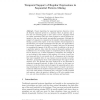Free Online Productivity Tools
i2Speak
i2Symbol
i2OCR
iTex2Img
iWeb2Print
iWeb2Shot
i2Type
iPdf2Split
iPdf2Merge
i2Bopomofo
i2Arabic
i2Style
i2Image
i2PDF
iLatex2Rtf
Sci2ools
CORR
2008
Springer
2008
Springer
Temporal Support of Regular Expressions in Sequential Pattern Mining
Classic algorithms for sequential pattern discovery, return all frequent sequences present in a database. Since, in general, only a few ones are interesting from a user's point of view, languages based on regular expressions (RE) have been proposed to restrict frequent sequences to the ones that satisfy user-specified constraints. Although the support of a sequence is computed as the number of data-sequences satisfying a pattern with respect to the total number of data-sequences in the database, once regular expressions come into play, new approaches to the concept of support are needed. For example, users may be interested in computing the support of the RE as a whole, in addition to the one of a particular pattern. Also, when the items are frequently updated, the traditional way of counting support in sequential pattern mining may lead to incorrect (or, at least incomplete), conclusions. For example, if we are looking for the support of the sequence A.B, where A and B are two it...
| Added | 10 Dec 2010 |
| Updated | 10 Dec 2010 |
| Type | Journal |
| Year | 2008 |
| Where | CORR |
| Authors | Leticia I. Gómez, Bart Kuijpers, Alejandro A. Vaisman |
Comments (0)

